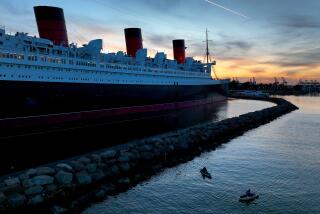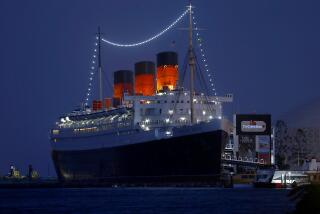Back Aboard the QE2
- Share via
With so much publicity about the plumbing and decorating problems on the Queen Elizabeth 2, plus heavy seas from recent Pacific storms and the cancellation of several previously announced ports of call, you’d expect most passengers to be comparing notes on toilets, seasickness and disappointment at bypassing Kobe, Japan, or Rabaul, Papua New Guinea, whose ports have been badly damaged by recent earthquakes.
But believe it or not, the hottest topic of conversation on our January sailing from the West Coast to Honolulu was an obscure 19th-Century law.
The reason so many people were talking about what is popularly (but erroneously) called the Jones Act, is that most of the 1,000 or so passengers who were to disembark in Honolulu had opted for the five-day Los Angeles-Honolulu segment of the refurbished ship’s world cruise.
The federal regulation, passed back in 1886 to protect American passenger ship business, forbids foreign-flag cruise lines from carrying passengers between two American ports. As a result, QE2 passengers were not able to board the ship in Southern California, but instead had to be bused five hours from Los Angeles to Ensenada and ferried to the ship by tender.
The Passenger Service Act (the Jones Act is a similar law enacted in 1920 to protect cargo shipping), forbids foreign flag vessels from picking up passengers in one U.S. port and dropping them off in another without calling at foreign ports in between. The QE2 is operated by the British-owned Cunard Line.
Numerous unsuccessful efforts have been made over the years to repeal the long outmoded law. (There are only two remaining ocean-going U.S.-flag vessels, American Hawaii Cruises’ Independence and Constitution, and these ships limit their passenger service to cruises within the Hawaiian islands.) Besides costing U.S. ports millions in lost revenue, the law is inconvenient for many passengers, particularly during the popular Alaska cruise season, when some passengers must be bused to Vancouver, Canada, from Seattle, to board a ship. In addition to the QE2, other cruise ships who have had to bus passengers to or from Ensenada on transpacific sailings this season include Princess Cruises’ Golden Princess, Holland America Line’s Rotterdam and Royal Cruise Line’s Crown Odyssey.
*
Meanwhile, aboard what is probably the world’s most famous ship, all the finished cabins were occupied for last month’s Hawaii sailing, just as they were on the previous segment, a Panama Canal transit. But the QE2 was not as full last December, when the ship’s much publicized troubles began.
The QE2 came out of dry dock for a scheduled Dec. 17 transatlantic crossing from Southampton to New York with its much-touted $45-million face lift still unfinished. About 600 passengers scheduled for the cruise boarded; another 400 did not (the ship’s capacity is 1,800). Both those who sailed and those who did not were offered full refunds.
For those who did board, rough seas ensued, causing more than just seasickness. Subcontractors were not able to complete work, causing passageways to be cluttered with construction materials. Toilets flooded and brown water flowed from taps.
The ship failed to pass its first U.S. Coast Guard inspection in New York, further delaying the departure of a sold-out Caribbean Christmas cruise. Some QE2 passengers whose cabins were still unfinished were transferred to the line’s Cunard Royal Viking Sun for a Mexico sailing.
A few plumbing problems continued during our transpacific crossing. The hues of the bathroom water in our cabin varied on occasion from faint yellow to a deeper rust shade, which Capt. Burton-Hall attributed to corrosion in the water lines during the month the ship was dry-docked. Several passengers reported toilets that didn’t flush (an inconvenience that was aggravated when one cabin’s occupant became seasick).
Repairs were made during the voyage, and hotel manager Engelbert Lanier termed the plumbing “under control” and said all carpeting was laid and public rooms and passenger cabins were complete. We did notice, however, that a new outside bar slated for the Sun Deck had not been built and that a planned teen club was unfinished.
As for the redecorating, the biggest change is in the dining rooms. Passengers once divided into first class and so-called “transatlantic” class are now divided according to restaurant seating assignments, which depend on what cabins they occupy.
Occupants of the most costly penthouses and suites dine in Queens Grill, with its own private cocktail lounge off-limits to other passengers. Next down are the two Princess Grills, one of them now renamed Britannia Grill.
The remainder of the former first-class passengers (those occupying E through J category cabins) sit in the new Caronia restaurant, which was relocated to the site of the former Mauretania restaurant.
This single move has caused the most complaints, according to Lanier, because women who dress for formal evenings liked the small stagelike entrance area at the top of the stairs, where they could linger briefly to be admired before descending to their tables in the old first-class restaurant.
Instead, that staging area has been given to the former transatlantic-class passengers, who dine at two seatings in the relocated Mauretania.
In the Princess Grill, where we were assigned to dine, we found the food disappointing compared to our earlier QE2 sailings. Soups were bland, fish overcooked and roasts tough.
The brand-new Crystal Bar serves passengers dining in the Caronia and the Princess and Britannia Grills, one of the ways the traffic flow around the ship has been improved by the new design. We do miss the pretty little private bars that each Princess Grill had before the renovations, however.
A new emphasis on Cunard Line’s tradition and history is evident throughout the ship, with artifacts from a striking 16-foot model of the 1906 Mauretania (with lights glowing from each porthole) to menus and silver serving pieces from the much-loved 1948 Caronia ship, nicknamed the Green Goddess for her unusual green livery.
While we think the whole refurbishment is a great improvement, especially in the ship’s library, now doubled in size, one frequent QE2 passenger and ocean-liner buff, David Giventer of Los Angeles, termed the renovations “an esthetic interruption on a period ship . . . a little too radical.” He feels the cruise lines have to understand that people become attached to certain areas of a ship and resist seeing them changed. When we saw Giventer again a day or two later, however, he enthusiastically urged us to go check out the new Chart Room Bar, where a singer-pianist performs nightly.
Other new additions: A British pub called the Golden Lion, which was filled day and evening with passengers sampling pints of draft lager, playing pub games or singing along with a piano player or a karaoke machine; a self-service restaurant seating 500; a glass-enclosed cafe called Pavilion, where early morning coffee and grilled sandwiches for lunch are served. Here, as in the Yacht Club, once open deck areas were enclosed for additional indoor seating.
The dance floor in the Queens Room has been enlarged. In the Grand Lounge showroom, the stage has been enlarged and a new sound and technical system installed. Four new cabins designed for disabled passengers feature extra-wide doors and large shower areas.
A two-deck spa with a full gym, indoor pool, aerobics center and thalassotherapy pool was introduced during a 1992 refurbishment.
To get information about upcoming cruises, call Cunard toll-free at (800) 221-4770.
More to Read
Sign up for The Wild
We’ll help you find the best places to hike, bike and run, as well as the perfect silent spots for meditation and yoga.
You may occasionally receive promotional content from the Los Angeles Times.






